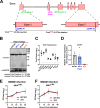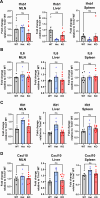Trim7 does not have a role in the restriction of murine norovirus infection in vivo
- PMID: 40464581
- PMCID: PMC12282188
- DOI: 10.1128/jvi.00816-25
Trim7 does not have a role in the restriction of murine norovirus infection in vivo
Abstract
Trim7 is an E3 ubiquitin ligase that was recently identified as a central regulator of host-viral interactions with both pro-viral and anti-viral activity in cell culture. As an inhibitor, Trim7 overexpression ubiquitinates viral proteins by recognizing C-terminal glutamines that are hallmarks of 3C-like protease cleavage events. Here, we sought to determine the physiological impact of Trim7 in resolving murine norovirus (MNV) infection of mice, as MNV is potently inhibited by Trim7 in vitro. Utilizing two independently derived Trim7-deficient mouse lines, we found no changes in the viral burden or tissue distribution of MNV in both an acute and persistent model of infection. Additionally, no changes in cytokine responses were observed after acute MNV infection of Trim7-deficient mice. Furthermore, removal of potentially confounding innate immune responses such as STING and STAT1 did not reveal any role for Trim7 in regulating MNV replication. Taken together, our data fail to find a physiological role for Trim7 in regulating MNV infection outcomes in mice and serve as a caution for defining Trim7 as a broad-acting antiviral.IMPORTANCEIntrinsic antiviral molecules that restrict viral replication are important drivers of viral evolution and viral tropism. Recently, Trim7 was shown to provide cell-intrinsic protection against RNA viruses, including murine norovirus. Biochemically, Trim7 recognizes the cleavage product of viral proteases, suggesting a novel and broad mechanism to restrict viral replication. Here, we tested whether Trim7 had a physiological role in restricting murine norovirus replication in mice. Unexpectedly, we found no impact of viral replication or innate immune responses during murine norovirus infection. Our findings urge caution in defining Trim7 as a broad antiviral factor in the absence of in vivo evidence.
Keywords: Trim7; murine norovirus; norovirus.
Conflict of interest statement
The authors declare no conflict of interest.
Figures





Update of
-
Trim7 does not have a role in the restriction of murine norovirus infection in vivo.bioRxiv [Preprint]. 2024 Oct 17:2024.10.17.618898. doi: 10.1101/2024.10.17.618898. bioRxiv. 2024. Update in: J Virol. 2025 Jul 22;99(7):e0081625. doi: 10.1128/jvi.00816-25. PMID: 39464121 Free PMC article. Updated. Preprint.
References
-
- Schwartz S, Vergoulidou M, Schreier E, Loddenkemper C, Reinwald M, Schmidt-Hieber M, Flegel WA, Thiel E, Schneider T. 2011. Norovirus gastroenteritis causes severe and lethal complications after chemotherapy and hematopoietic stem cell transplantation. Blood 117:5850–5856. doi: 10.1182/blood-2010-12-325886 - DOI - PMC - PubMed
MeSH terms
Substances
Grants and funding
LinkOut - more resources
Full Text Sources
Medical
Research Materials
Miscellaneous

